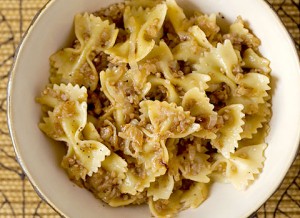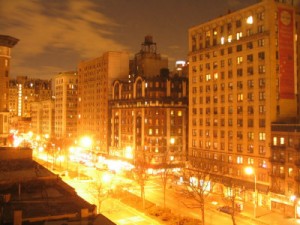HG has been rereading some works by I.B. Singer (In My Father’s Court, The Magician of Lublin, Satan in Goray) and I.J. Singer (Yoshe Kalb.) This is a plunge into the vanished world of the Jewish Chassidim of Poland, a strange environment of fervent religiosity, Talmudic scholarship, superstition, mysticism. A world wiped out by the German murderers. Beyond the spiritual, the Singer books provide plenty of descriptions of traditional Eastern-European Jewish food-ways from everyday eating to wedding dinners to the opulent feasts of the more prosperous rabbinical courts. HG was struck by the omnipresence in these descriptions of kasha (buckwheat groats). Kasha with milk for breakfast. Kasha in chicken soup. Kreplach (a sort of Jewish ravioli) stuffed with kasha. Knishes stuffed with kasha. Bowls of kasha with onions. Indeed, kasha seemed the staff of life for many Polish and other Eastern European Jews. HG, the son of Jewish/Belorussian immigrants, ate lots of kasha at the family table. Loved its robust nutty flavor. Still love it. HG enjoys it in a bowl of steaming beef or chicken broth. Enjoys it as an accompaniment to brisket and gravy. Enjoys it mixed with farfalle (butterfly shaped) pasta in a dish called kasha varnishkes. HG has a fervent attachment to this dish when it is topped with fried onions and mushrooms. Accompanied by a bowl of sour cream or Greek yogurt, of course. When winter chill arrives, HG watches NFL playoffs on TV. Before HG is a bowl of onion-mushroom-kasha varnishkes, Sour cream. A bottle of dark beer. A glass of ice cold vodka. Happy times.
Kasha
July 23rd, 2013 § 1 comment § permalink
The Triumph of BSK Vegetables
March 11th, 2013 § 0 comments § permalink
“Eat your vegetables!!” “Finish your brocoli — or no dessert!!” “Eat them — they’re good for you!!” Yes, as children, we were all subject to threats, pleadings and promises regarding vegetables. And, naturally, this has led to resistance. What didn’t come across was the fact that vegetables, if treated properly, are very tasty and worthy companions to good red wine. Witness the roasted vegetable platter prepared this week by life companion BSK. Neither a doctrinaire vegetarian nor a rigid health nut, BSK nonetheless glories in vegetables and treats them imaginatively and with dignity. For the vegetable dinner, BSK filled a baking pan with cauliflower florets, slices of red pepper, radishes,fennel slices, chick peas, chunks of turnip and carrot, Brussel sprouts. This colorful melange got a nice dousing of garlic infused olive oil plus a sprinkling of ground pepper, kosher salt and Goya Adobo. For crunch, BSK topped the vegetables with some finely chopped pancetta (a bow to HG’s infatuation with Italian piggy products). Into a 375 degree oven. Roasted into levels of crisp and unctuous. BSK also cooked some quinoa with onions and mushrooms in chicken stock. This was the centerpiece of the vegetable extravaganza. A companion was a very big bowl of Greek yogurt enriched with oil, garlic, Tsatziki spices, some preserved lemon and piquant Spanish smoked paprika. Adding a Middle Eastern touch was a small dish of harissa. Delicious. Some worthy folks like George Bernard Shaw and I.B. Singer were dedicated vegetarians. HG doubts they ever tasted anything as good as BSK’s creation even with the pancetta and chicken broth eliminated.
Young New Yorkers Living in Expensive Closets: Read This And Weep.
October 10th, 2012 § 0 comments § permalink
Some 48 years ago (seems like yesterday). HG, BSK, their two adorable children, their live-in mother’s helper and their poorly trained but decorative standard poodle, lived in a 12th floor Upper West Side apartment with dramatic views of the Hudson River and the New Jersey Palisades. A very spacious residence. Big living room. Big, separate dining room. Nice windowed kitchen and pantry. Four bedrooms and three baths (one en suite). The rent: $274 a month (later raised to $292 and a similar apartment in the same building now rents for $15,000 a month). Ah, rent control, you lovely bit of legislation (of course, obtaining this rent controlled paradise involved some bribery, chicanery and corruption). This did not shock HG, a born and bred New Yorker. In those days the Upper West Side was affordable and diverse. There was still a heavy Jewish influence. Big time theater and entertainment folks (Abe Burrows, Leonard Bernstein, Isaac Stern and many more) lived on Central Park West alongside many affluent professionals and business persons. Side streets from Central Park West to Broadway were gritty (except for W. 67th Street, site of the Des Artistes apartment house and many studios of painters and musicians). Riverside Drive and the Avenues and cross streets west of Broadway were filled with intellectuals and creative types who had more brains and talent than money. Forget Greenwich Village. The Upper West Side was the home of professors, critics, novelists, dancers, journalists, composers, actors, musicians and school teachers. Lots of European intellectuals who had fled Hitler and many Holocaust survivors (the little, pale, Nobel Prize winning writer, Isaac Baashevis Singer, who lived on W. 86th Street, often wrote about them). The Heresford (West Side apartment houses often had British names, a touch of Anglophile class) where HG and BSK lived, had much artistic ferment. Among its residents were Peter Boyle (before Hollywood and TV fame); film composer Michael Small, the critic and editor Ted Solotaroff; Gary Null, the health and sex writer, guru and radio personality. There were also some Broadway dancers, the cantor of a major synagogue and lesser artistic lights. The Upper West Side was filled with movie theaters showing art films (the New Yorker, Thalia and Symphony) and plus the first run houses (Loew’s 83rd, the Beacon,etc.). Food was a neighborhood obsession. Zabar’s, of course, but also Murray’s (preferred by some smoked fish aficionados) and Barney Greengrass (unsurpassed sturgeon). Middle European restaurants like Eclair and dairy restaurants like Steinberg’s and Paramount. Gitlitz’ Delicatessen on Broadway and 78th ( much superior in HG’s informed opinion, to Katz’s, Carnegie or 2nd Avenue Deli). The jewel of the West Side was the Tip Toe Inn (on Broadway near 86th Street). A huge place with a huge menu. Everything was delicious and inexpensive (the New York Public Library has a nice collection of old menus….Here’s a link to Tip Toe’s 1954 menu. Be astonished). There was a rotisserie in the Bretton Woods Hotel (86th and Broadway) that barbecued ducks and chickens. Sunday dinners for HG and BSK often featured one of those juicy, crisp skinned ducks and an avocado-sweet onion-sliced orange salad. Chinese restaurants were clustered around Broadway and 96th and they were very good (the first Szechuan restaurant in New York was on Broadway and 95th). There were also some Cuban/Chinese places where you could get good shrimp dishes plus Moros y Cristianos (black beans and rice) Fairway didn’t exist but for those who liked to eat at home there were butchers like Endicottt Meats and Nevada Market (where you could get some exotic stuff including bear, in season). Good bakeries. Mom and Pop greengrocers. Citarella’s for fish. Broadway Nut Shop for sweets. Daitch Dairy (79th and Broadway) for tub butter and cheese. Bretton Wood Rotisserie for barbecued ducks. HG and BSK were not plutocrats but could afford all of these good things. Yes, the Upper West Side had lots of junkies, hookers, muggers and burglars. Their presence made West Siders feel superior to residents of the antiseptic Upper East Side. Now, let HG make you young folks really jealous. HG, BSK and family spent all summer plus spring and fall weekends at their Fire Island home. Built atop a dune it had panoramic views of the Atlantic Ocean and Great South Bay sunsets. The family bought it for $40.000. HG’s first Fire Island house (in 1959) cost $4,000 ($1,000 for land and $3,000 for two bedrooms, bathroom, kitchen, living room and deck). In 1960, HG added two more bedrooms, another bathroom and additional decking. Cost: $2,000. That’s right. The numbers for these Fire Island properties are correct. Read and weep.
More Schlag, Please, Herr Doktor.
June 4th, 2011 § 40 comments § permalink
With the delicious irony that only Middle Europeans are capable of, waiters at the long departed Eclair Bakery/Restaurant on New York’s West 72nd Street, referred to each other as “Herr Doktor.” Eclair’s heyday was the late 30’s through to the 60s. Its customers were the Europeans, primarily Jewish, who had fled Hitler and wound up, for the most part, in the Washington Heights and Upper West Side neighborhoods of New York. Yes, many of the waiters had been Doctors in Europe, or lawyers, or architects, etc.. In New York they were waiters. They did not bewail their fate. They were alive.
Eclair catered to displaced novelists, musicians, singers, actors, artists and a host of intellectuals of every cerebral and artistic variety. And, the little, bald guy in the corner was Isaac Bashevis Singer (long before he became famous), eating his inevitable (he was a vegetarian) tuna fish sandwich. The women in the Eclair were bosomy, voluble, perfumed and flirtatious. It was a sexy place, echoing Viennese, Budapest and Bucharest coffee houses. The pastries were outstanding. Coffee came adorned with three inches of schlag (whipped cream). It was more than a bakery. Eclair was also a restaurant with outstanding wiener schnitzel, chicken paprikash and other artery clogging specialties of Mittel Europa. A multitude of languages was spoken at Eclair—German, Russian, Polish, Hungarian, Czech, Yiddish, Rumanian. To HG’s young ears it was all music. Eclair was owned by A.M. Selinger, Italian-born, Czech-reared. When he died in 1998 his New York Times obituary summed him up perfectly: “However long they lingered, the Eclair customers found a ready welcome from the proprietor, a small, natty man of legendary conviviality. a wide circle of friends and a vast array of pluperfect pastries.”



